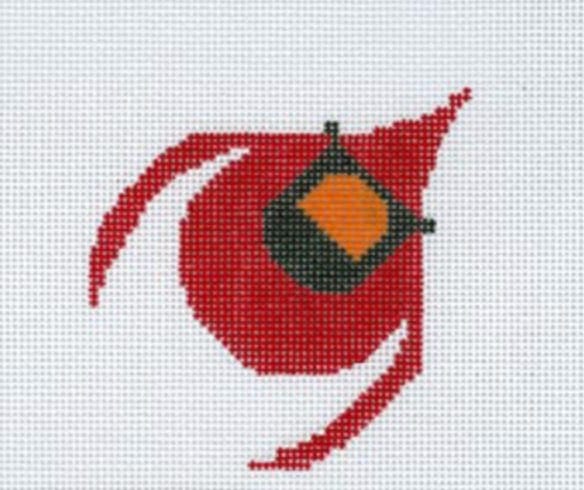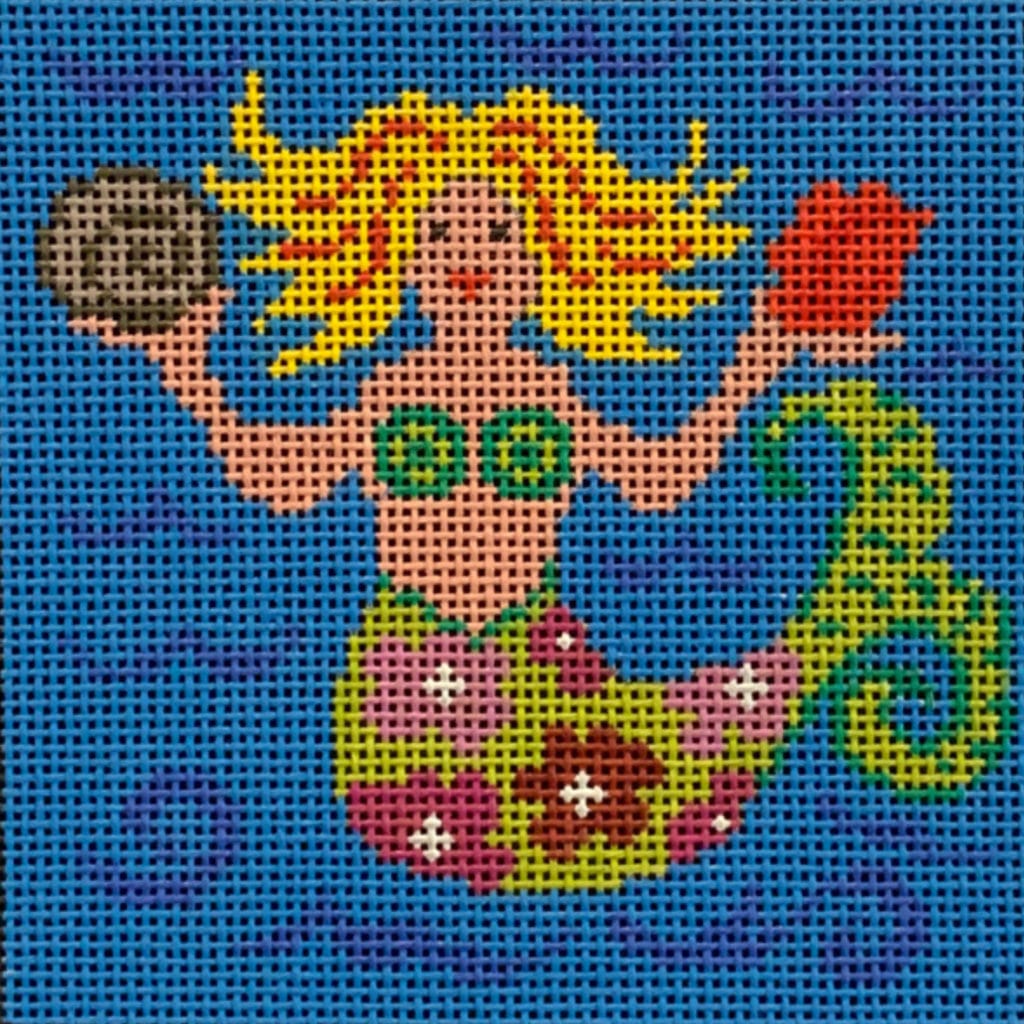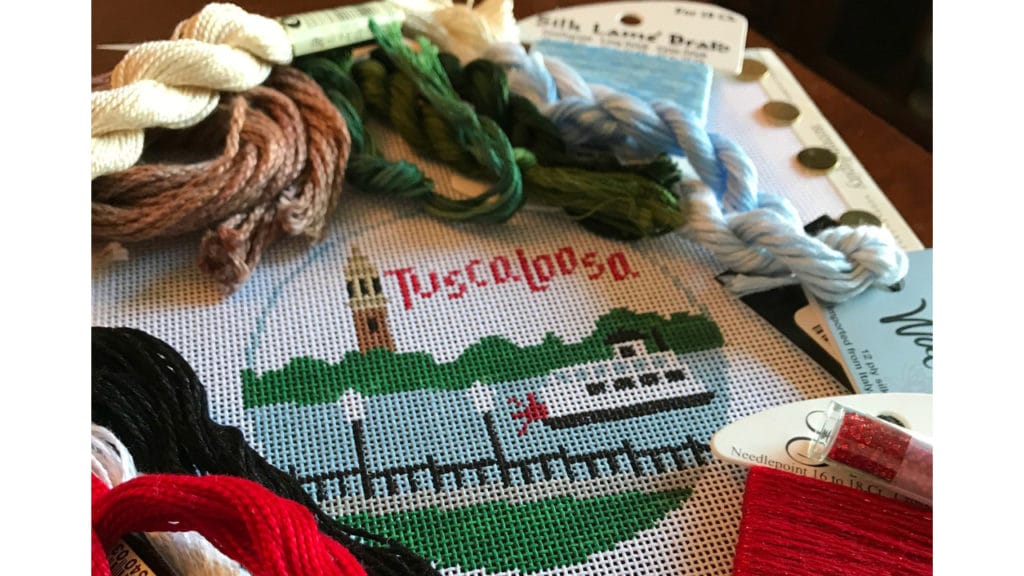Are you a new stitcher? Perhaps you’re coming back to needlepoint after a bit of a break. Wherever you are on your adventure in stitches, I’m here to help you choose your first – or next – project with confidence.
See, I’m a former needlepoint shop owner, so I have some handy dandy tips that will help you narrow down your choices. And I just love sharing what I’ve learned through the years with my followers. Ready to dive in? 🙂
Tip #1: 13/14 mesh canvas works up more quickly – and it’s easier to see.
That’s why I recommend it for new stitchers. Not only will you feel like you’re zipping through your project, it’ll be a lot easier on your peepers, too. 😉
And if you don’t know what I mean when I say “13/14 mesh canvas”, that’s absotively posilutely okay. It’s really quite simple, once you have the explanation.
The number refers to the number of canvas threads/intersections in a linear inch of needlepoint canvas. So if your canvas is 13 mesh, you will work 13 tent stitches in a linear inch. If your canvas is 14 mesh, then you’ll work 14 tent stitches in a linear inch and if it’s 18 mesh, you’ll work 18 tent stitches in a linear inch. (By the way, those are the three most common sizes of needlepoint canvas.) If you want to know more, I have a whole blog post about the different kinds of needlepoint canvas that you can read here.
Tip #2: Choose a smaller canvas for your first project.
I know it can be soooooo tempting to buy that gorgeous 16″ x 16″ floral design. I mean, it’s perfect for your sunporch, right?!
Well, hold that thought and consider this…
A small piece will stitch up a lot more quickly than a large – or even medium sized – one. In fact, the “end” will be in sight almost from the beginning. And you’ll have the satisfaction of completing something quickly so that you can move on to your next project sooner rather than later. YAY!!
Some of my favorite small projects include…
- eyeglasses cases
- scissors cases
- ornaments
- bookmarks
- coasters
- key fobs
- luggage tags
Just be wary of small designs that have fine details. All of those details usually mean lots of colors, and, with that, comes a lot of thread changing.
Tip #3: Avoid canvases with lots of shading.
I know – they’re absolutely knock-your-socks-off gorgeous. The problem is that they can also be challenging to stitch. It’s hard to tell when to change colors if the shading is very subtle. And it takes practice to hone your skills so that the transition from one shade of thread to the next is seamless. To avoid frustration in the beginning, choose pieces that feature larger blocks of color.
“Cardinal Flying” from Charlie Harper is a terrific example of the kind of canvas you might choose for your first project.

Some of my favorite needlepoint artists who, I think, do a great job of creating fun-to-stitch designs without a lot of shading include:
- Charlie Harper Designs
- Danji Designs
- Kathy Schenkel Designs
- Pepperberry Designs
- The Princess and Me Designs
Tip #4: Choose a canvas that is stitch painted.
Not sure what that means? No worries… I’ve met stitchers with years of experience who didn’t either. 😉
When a canvas is stitch painted, it means that each canvas intersection is painted a specific color to create a precise design so that the stitcher knows exactly what color the artist intended him/her to stitch at that place on the canvas. In other words, there’s no guessing as to which color you should make your stitch because the intersection is clearly ONE color. There are no half-blue/half-green canvas intersections – or whatever other combination you might find – on stitch painted canvases.
This mermaid by Patti Mann is an example of a stitch painted canvas…

Tip #5: Stick to squares and rectangles.
Straight edges are much easier to stitch than curves. I can’t count the number of times I’ve seen stitchers try to “smooth” the curves on a round ornament, only to end up with a lopsided egg shape. (Hint: You’ll never smooth out the curves around the entire circumference of a circle… one side will always look a little jig-jaggy. Chalk it up to “needlepoint physics”. 😉 )
Tip #6: Use single strand threads on your first project.
As a matter of fact, I recommend sticking to single strand threads until you have at least 3 or 4 canvases under your belt.
What is a single strand thread? It’s a thread that you use “as is” right off the card, spool, or skein. That means it’s non-divisible.
Some examples of single strand threads include…
- DMC Perle Cotton#3 and #5
- Appleton Tapestry Wool
- Silk and Ivory
- Planet Earth Silk
- Planet Earth Wool
- Vineyard Merino Wool
- Vineyard Classic Silk
And last, but not least…
Tip #7: Your first project should be one that you L-O-V-E!
You’re much more likely to stick with it and finish your first project (and every one that follows!) if you really like the design. Choose a subject that makes you smile. If you love to garden, consider a floral design. Or if the beach is your happy place, choose a seaside scene. You get the idea… 😉
Alrighty, my friend. That’s all for now.
Thank you ever so much for popping in. Have a terrific rest of your day and, until next time, happy stitching!
XOXO!!

PS: For more needlepoint tips, subscribe to my weekly email, NeedleNotes, here.




